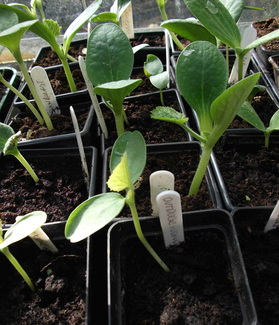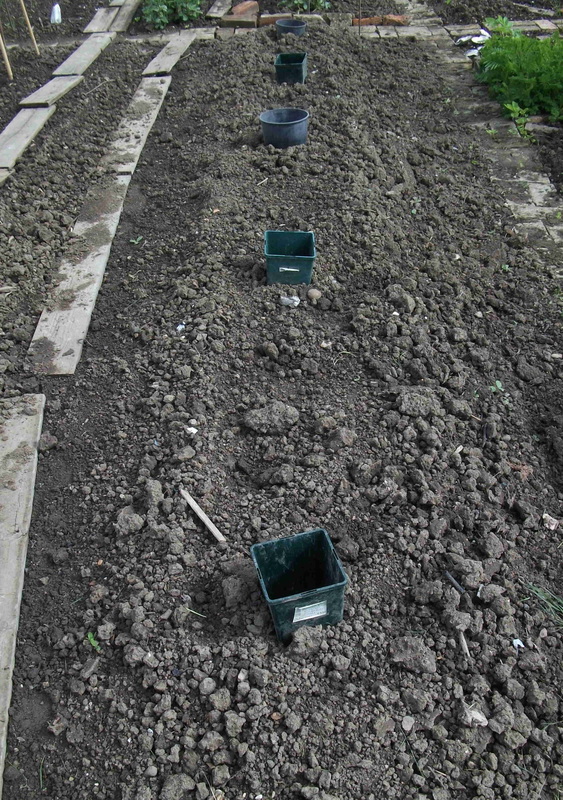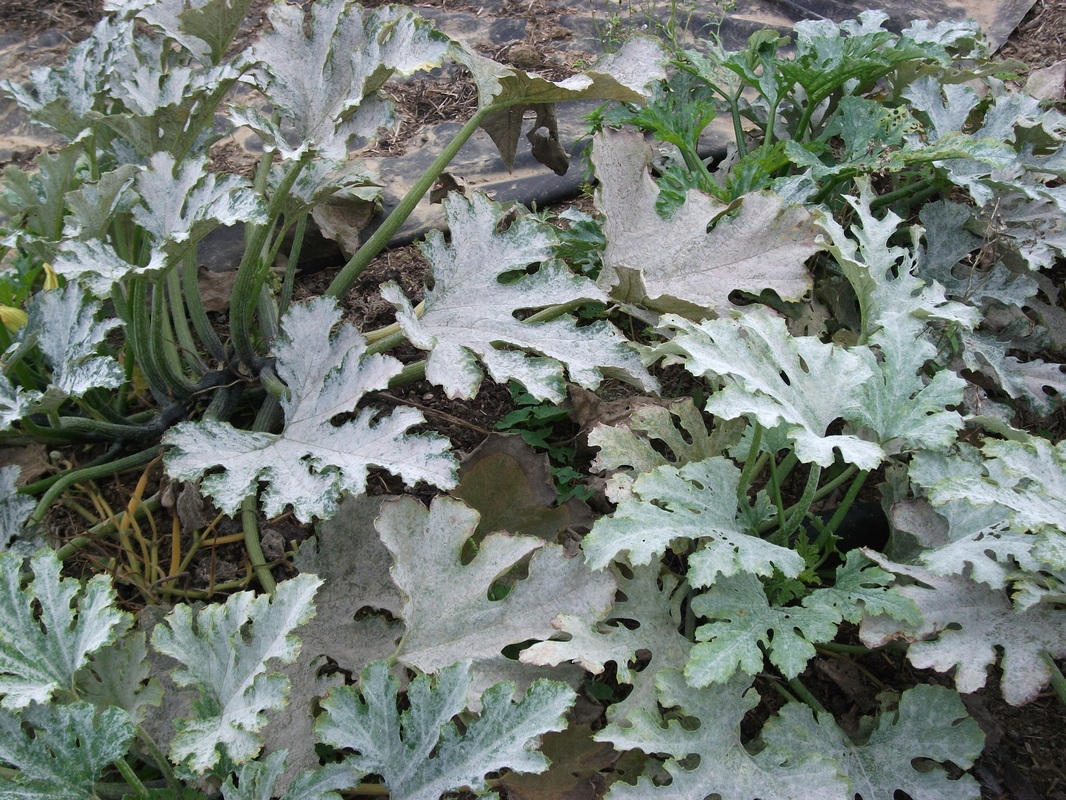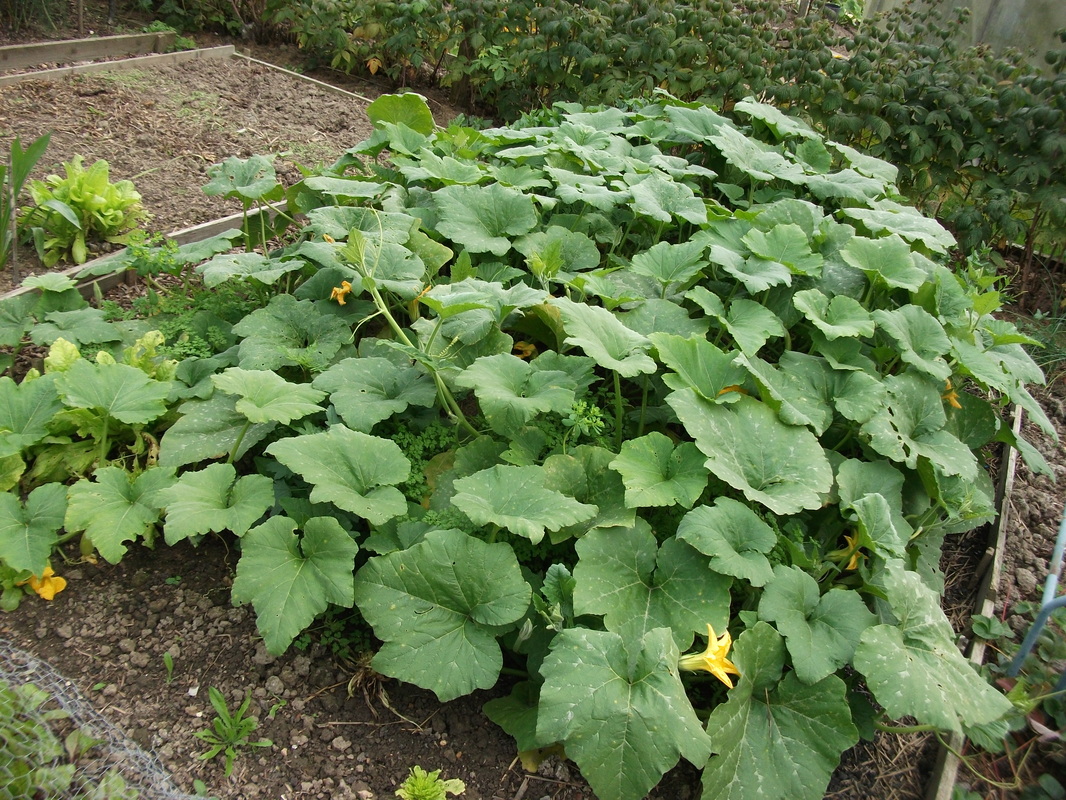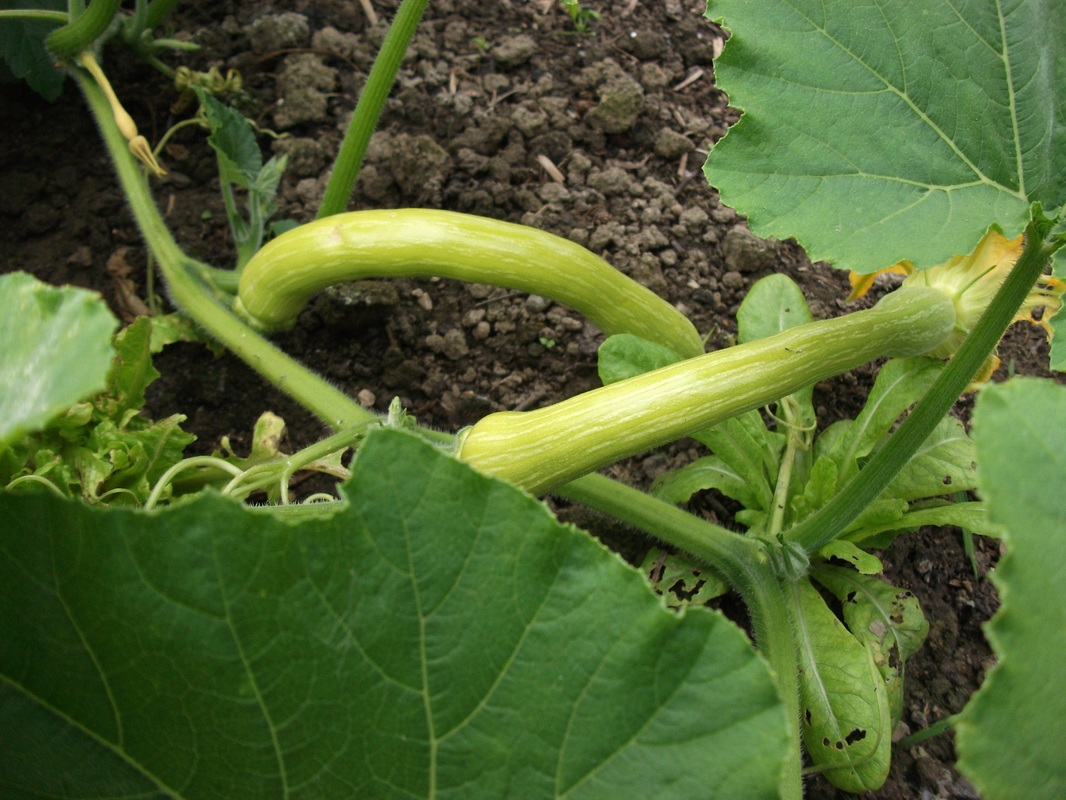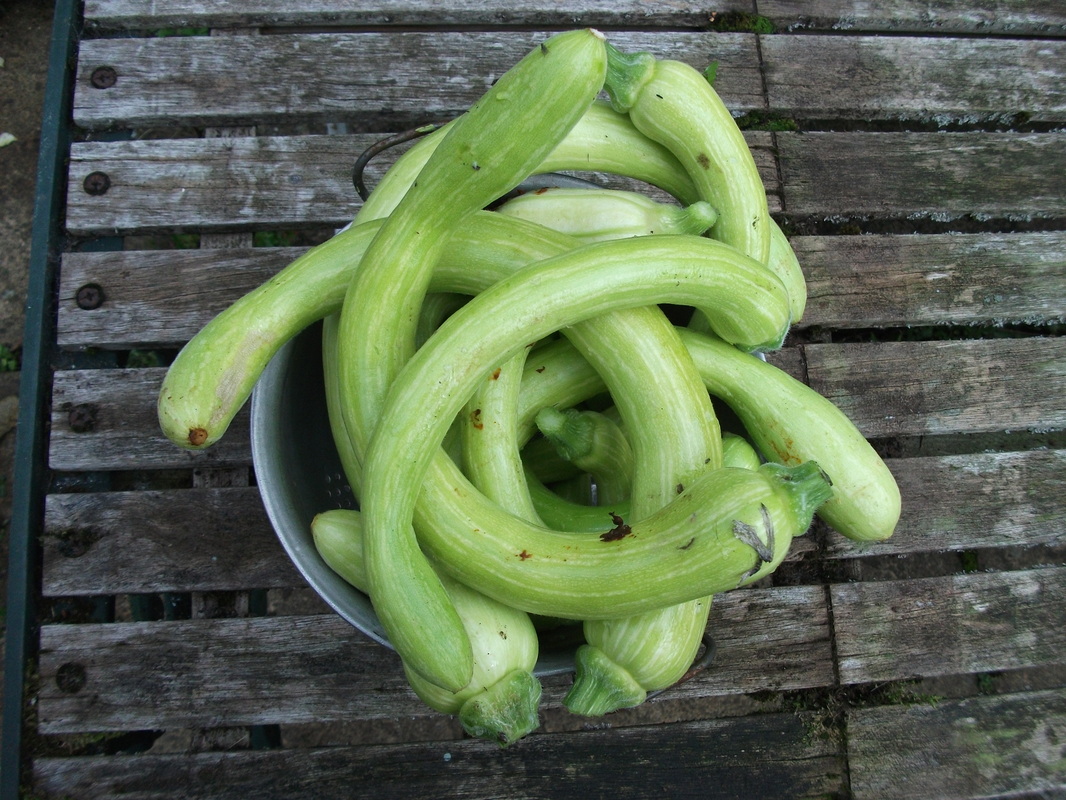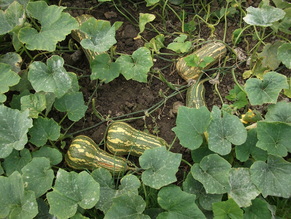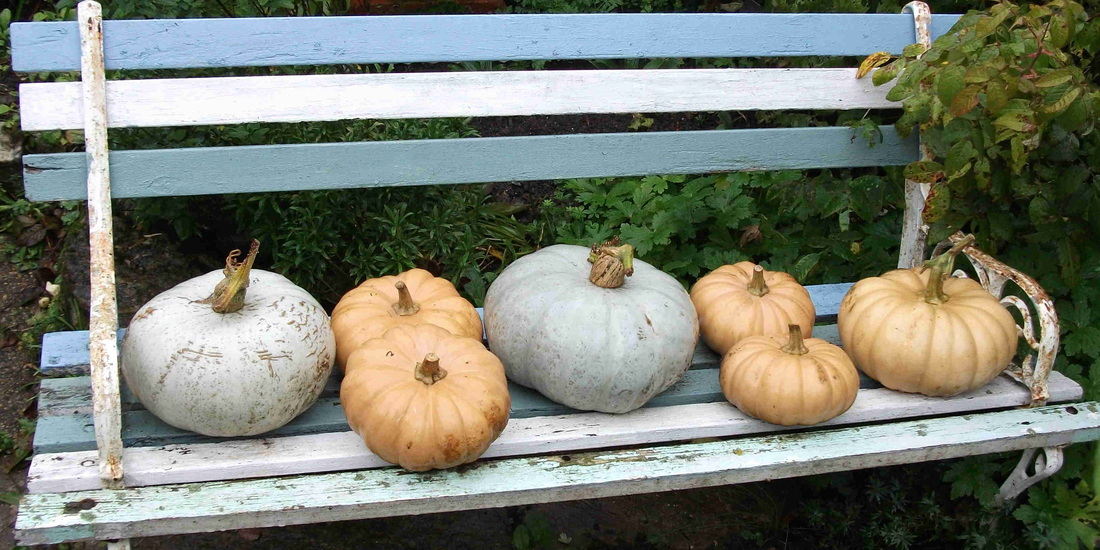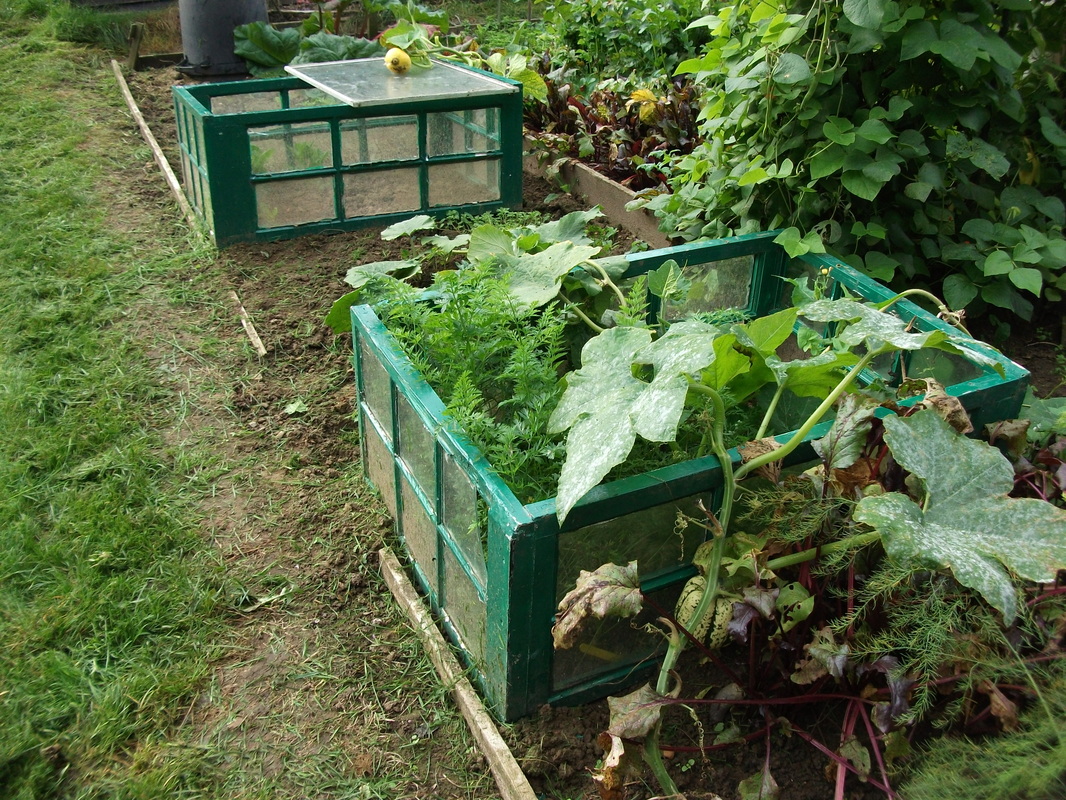This family includes marrows, summer & winter squash, cucumbers & melons. Here we deal with marrows, courgettes & squash.
All these plants like very much the same conditions, and can be grown side-by side. To get the best from them read our tips from experienced gardeners.
The marrow family like warm, steamy weather. They can't cope with even the hint of frost, so we start the plants off in a warm greenhouse or kitchen windowsill and grow them on in pots until it's warm enough outside to plant them out. In Kent, that's usually mid -May, when night-time temperatures are very unlikely to fall below 5degC. Plant them out before then and you risk losing them, unless you have a close-fitting cloche or polythene cover that can be put over them. Even a hint of cold may cause them to become stunted; They "suffer a check" which means the plant goes into self-defense mode and shuts down all growth. A prolonged spell of warm weather is then necessary to start it into growth again, so it may well never catch up with plants that were put out a week later.
|
Don't sow the marrow family in trays. Separating the seedlings is rarely successful. To avoid damage to fragile young roots sow seeds one or two to a small pot. (If both come up, be ruthless and cut one off). Warmth is needed for the seeds to germinate; a heated propagator or warm sunny windowsill are both ideal. Make sure the young plants get plenty of light once they come up: too little light will lead to leggy, weak plants.
Left: young plants of the squash family in individual pots; where there are two seedlings these will be singled by cutting one out. |
|
The secret of good results is, as with so many plants, good soil preparation. Traditionally this family are grown on 'marrow mounds' and this is still ideal. Dig a wide, shallow trench and fill it with compost from your compost heap (rough old stuff is fine). Some gardeners open up the trench in autumn and fill it with whatever comes to hand during the winter, letting it rot down where it lies.
Once the trench is filled, draw the soil back over it and shape it to a neat flat-topped ridge. While the plants are young, you need to make sure they get enough water - a pointed ridge will let the water run off! Setting old pots into the ridge means water goes straight down to the mature roots when the plants are big, instead of running off all over the place.
Right: a marrow mound ready for planting up with courgettes etc. |
The main problem with the marrow family is mildew, which silvers the leaves in late summer and stops growth. A little mildew can be ignored, but a bad case will affect your crop. Mildew occurs when a plant is dry at the roots but the air is damp. The traditional mound, by holding water at the root but keeping the leaves up in the air, reduces the problem. While drought may not be much of a problem in some parts of the country, relying on rain to keep the plants wet enough in Kent is usually doomed (last year excepted) and gallons of extra water have to be given to get good results. Anything that helps keep water round the roots is a good plan.
Success with courgettes and summer squash
Courgettes are picked young - the younger the better. that way you get a constant crop of tender veg. Keep picking them, even if you end up giving them away. Allowing them to get too large not only means the courgettes themselves are coarser, the plant also slows down production of new ones.
The problem is that most courgettes are green - it's all too easy to miss one under the lush foliage until suddenly you spot it - a monster. With courgettes, this can happen in a few days. The best way round this is to grow a variety which is a different colour from the leaves, like one of the yellow varieties, or palest green variety 'Lebanese White'
Courgettes don't freeze successfully and are strictly a summer treat. Summer Squash are essentially similar, with the same needs, a slight variation in taste and a range of attractive shapes. Prettiest are the 'patty pan' squash - so called because they resemble little scallop-edged flan dishes, which are available in bright yellow and pale whitish green. Like courgettes, they must be picked daily or they rapidly become inedible monsters. Recipes which work for courgettes also work well for summer squash.
Most summer squash are 'bush' - in other words, they don't trail. But one trailing variety which is absolutely superb is 'Tromba', available from Franchi seeds. Very healthy, it produces enormous quantities of squash, like a long curly courgette both in shape and taste, till the autumn frosts cut it back. One plant of Tromba will provide enough for a family, so it is very good value for space. If you have a new plot, you can prepare a planting hole for it and let the growth trail over your weed-suppressing fabric during the summer.
The problem is that most courgettes are green - it's all too easy to miss one under the lush foliage until suddenly you spot it - a monster. With courgettes, this can happen in a few days. The best way round this is to grow a variety which is a different colour from the leaves, like one of the yellow varieties, or palest green variety 'Lebanese White'
Courgettes don't freeze successfully and are strictly a summer treat. Summer Squash are essentially similar, with the same needs, a slight variation in taste and a range of attractive shapes. Prettiest are the 'patty pan' squash - so called because they resemble little scallop-edged flan dishes, which are available in bright yellow and pale whitish green. Like courgettes, they must be picked daily or they rapidly become inedible monsters. Recipes which work for courgettes also work well for summer squash.
Most summer squash are 'bush' - in other words, they don't trail. But one trailing variety which is absolutely superb is 'Tromba', available from Franchi seeds. Very healthy, it produces enormous quantities of squash, like a long curly courgette both in shape and taste, till the autumn frosts cut it back. One plant of Tromba will provide enough for a family, so it is very good value for space. If you have a new plot, you can prepare a planting hole for it and let the growth trail over your weed-suppressing fabric during the summer.
Vegetable marrows
Vegetable marrows are just a larger version of courgettes. Though specific marrow varieties are available, most courgettes will do a convincing impersonation of a marrow if you ignore them for a few days. While marrows are less popular than they were, they still retain a few loyal fans. Marrows are grown in exactly the same way as courgettes. They should be picked while still young and reasonably tender - maybe 12-15" in length (30 - 35cm), unless you are trying to grow an inedible monster for the Harvest Festival.
Success with winter squash - butternut, Crown Prince etc
Winter squash are allowed to remain on the plant until fully ripe - eat them earlier and they taste bitter and nasty. The best known winter squash is butternut - not a variety but a species, of which many seed varieties are available. Butternut isn't actually the easiest to grow - in fact, it's one of the hardest - and if you're a first-time grower you are better off trying one of the other winter squash which are available.
|
'Crown Prince', a variety of Queensland Blue squash (only the outside is blue-green, the flesh is the usual orange), is a good one to start with if you have room for a trailer. Other varieties are compact 'bush' types. It is always worth searching catalogues for squash varieties - one place the internet comes into its own - as there are many varieties available (still only a fraction of what is grown in the USA) but few mainstream seed companies stock more than a couple of common ones.
|
Above: Butternut squash 'Barbara'
|
|
Once squash have finished growing they need to ripen in the sun. As the plant dies back, remove the squash to a place of safety and lay them out in the sun to ripen and 'cure'. The skins will harden and the squash then will keep right though winter in a cool frost-free place.
Seen here: Crown Prince and Autumn Crown |
Outdoor cucumbers
A generation ago, 'ridge' cucumbers - so called because they were grown on a ridge, as explained above - were miserable things that had to be peeled before eating, were full of seeds and bitter in taste. Definitely the poor relation of 'proper' cucumbers. In recent years, plant breeders have produced a number of varieties which are every bit as good as greenhouse ones. In fact, it hardly seems worth giving up valuable greenhouse space to cucumbers these days.
|
However, you will still get better results in cool weather if you can give the plants a little protection - either from a cold frame or from some proper allotment-style lash-up such as that seen on the right. You can put your plants out earlier if you can give them some protection, and will extend the cropping season for a week or two in autumn.
Once you've tasted home-grown cucumbers you'll never want to go back to shop ones! |

